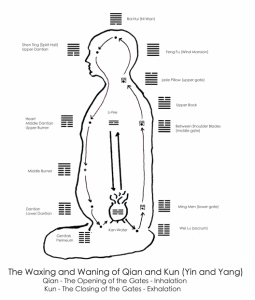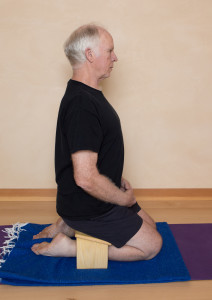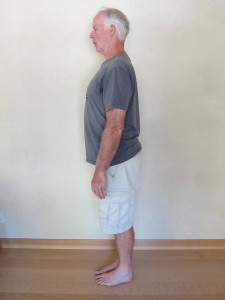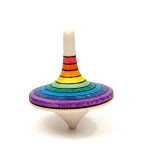Notes From the workshop at Bija Yoga in San Francisco, April, 2017, and more…
1 Intention and Attention
2 Forest and Trees
3 Lines and Circles
4 Living in Three Dimensions
Intention and Attention
Intention and attention are the twins that help us remain rooted in the present moment. Of course, we have to begin with the intention to stay awake and present. From there we attend to whatever it is that will help us realize this intention. The interplay between intention and attention will show up anywhere and anytime we find ourselves looking to go deeper into our soul journey. Stable Loving Presence is a term I am using to help organize the focus of our intentional and attentional possibilities as we continue our work to heal ourselves, human culture and our planet.
What is our intention for this class, this moment, this lifetime? Every moment, if we are staying awake, we get to choose our intention. We have no control over what may arise, in our minds or in life, but we do have the capacity to respond to whatever arises from the spacious, open present moment and not from conditioned habit. If we want to be a vehicle of sanity and kindness in an insane world, we need the intention to choose the open spaciousness of love over contracted and unconscious fear as our base for responding to the moment, every moment. If this is our life’s intention, we need to explore just what this means. When fear, or any of its related emotions such as anxiety, anger, shame and others, arises, as they will, over and over, day after day, what determines how we respond? We have to be paying attention to find out!
In general, habit rules our responses. A common reaction to difficulty or unpleasantness is to shut down/contract our heart center as a means of self defense. These challenges can come from the outer world, or from within the depths of our own psyches. We all carry many lifetimes of psychic and emotional wounds and we have ‘learned’ to ‘close down’ to keep from revisiting the old ones, or being wounded again. Unfortunately, as we all learn sooner or later, this strategy does not work in the long run. Closing down perpetuates a sense of separation, and this alienation from wholeness, and aspects of ourselves, is the true source of our suffering. We might call this the major spiritual disease of our times. Somatically, we feel this as contracted restricted energy.
Option two is to embody the negative emotion and get lost in it. We become the anger, anxiety or fear and the fullness of our world collapses. Our strengths and resources for dealing sanely with the moment become forgotten in the unconscious passion. This is happening collectively all over the planet, as people bond with others lost in similar fears and anxieties and act out in violence and stupidity. In both of these choices, we have lost the space of the present moment.
Option three is to stay present, open and alert, holding some level of spaciousness, wisdom and compassion, even as fear, in any of its variations, arises. If necessary, we respond to the demands of the moment, as best possible, with compassion for ourselves and others, and as much wisdom as we can summon, and keep going, moment by moment. This requires a certain level of emotional and spiritual strength, cultivated through practice. A spiritual practice involves stabilizing an awakened loving presence, so just physical exercise or mental training will not be sufficient. And this practice primarily involves paying attention.
When we have as our primary intention in life to cultivate stable loving presence, every moment of our lives offers a chance to practice. We are not limited to the yoga mat or meditation cushion. And every moment we get to start anew, to be a beginner in life, hopefully recognizing that we are children in this practice, still learning and prone to mistakes. But we have to be paying full attention to what is actually arising. Most of the time we pay just enough attention to get by, but most of our mental energy is engaged in our habitual ‘lost in thought mode’. The more we practice staying fully present, the easier it gets. Of course, the spiritual irony is that stable loving presence is our natural state; we just seem to have forgotten and have become lost in our own delusions of self, in all of its stories.
Through practice, or grace, the awakening from our delusion slowly emerges, but even if a major spiritual shift has not yet taken place, we all have access to the present moment and can practice staying present. “Being steady with mindfulness as an anchor for all the changes we go through is the way we practice forbearance. And you can employ this same method anywhere and anytime: just pay close attention to the detail of what is going on internally and externally. Don’t flinch, don’t run away. Trust what happens. Take your stand there.” 
Forbearance is another word for equanimity, (Yoga Sutras) samatvam, (Bhagavad Gita) or emotional resilience (Pema Chodron) . Zen priest and poet Norman Fischer, writing in his fascinating book ‘Sailing Home” is describing basic Zen practice, but the mindfulness he discusses is the root of all spiritual practices. In the body, notice that while fear or anxiety contracts the energy, you can slow that process down moment by moment, if you hold presence. The fear dos not go away necessarily, and if there is trauma associated, there will be a lot of work to hold presence, but you can do this. Keep you intention clear and your attention sharp.
‘Sailing Home‘ is also a book about stories, both personal and collective, and how we can use them wisely, without ever confusing them for absolute Truth. Our spiritual journey parallels that of Odysseus on his great journey. We never know when one of the many hidden places in our unconscious, triggered by life experience, is going to jump out and create trouble. Emotional stability and resilience is a very important skill to cultivate. I am using the expression ‘stable loving presence’ as it captures the three qualities of ground, heart and openness that are the key for this resilience.
Our somatic explorations in yoga will show how we can embody and nurture stable loving presence, (SLP), through diligent, careful practice. ‘Sthira sukham asanam‘, Patanjali’s description of asana is also a description of stable loving presence. Krishna, in chapter 2 of the Bhagavad Gita, calls this ‘sthitha prajna’, stable wisdom. SLP requires the brain to surrender to the heart, the entire body to deeply ground into Mother Earth, and hours and years of practice. Patanjali offers abhyasah, as the very first practice in the Yoga Sutras.
I-13 tatra sthitau yatno’bhyasah
Practice leads to stable healthy mind states and stillness.
I-14 sa tu dirgha-kala-nairantarya-satkarasevito drdha-bhumih
Stability of mind requires continuous practice, over a long period of time, without interruption, and with an attitude of devotion and love.
Deeply ingrained habits do not go away overnight, whether in an individual or a society. The neuronal connections can be strongly wired, especially if they have been repeated over and over. Laying down new neural pathways and weakening old ones take time and patience. The intention to sustain devotion and love are required to make sure the new pathways are healthy and not dysfunctional. It is quite easy to react to an unhealthy pattern by creating another unhealthy one. “”I hate myself for having all this judgment,” is a common thought/vrtti. Learning to gently and compassionately see the thought and recognize it for what it is requires discipline and patience. This then leads to the process of letting it go. This is vairagyam, described in sutra I-15. There are many vrttis floating about the mind field that are triggers for suffering. Vairagyam is sustaining a healthy and alert immune system for the mind.
Forest and Trees
We will look at what this means in life, as well as how our asana explorations can deepen the openness of our heart and the stability of our grounding. Remember to balance the view of the forest with the details of the trees in your practice. Obsessing over detail (trees) never allows you to rest in the openness of the present moment. For those of us trained in the Iyengar system, it is easy to get seduced by the endless pursuit of perfection. In the world of form there is always one more adjustment, one more instruction to remember, one more prop, one more nuance to notice. To be stuck here is the sign of a restless mind. In any asana, just choose a few points to awaken, using an energetic pattern to anchor your attention and  integrate the flow, and then step back and ‘be’. If and when you become distracted, repeat the cycle. (For more detail on this way of practicing, see Samyama in Asana pt1) and pt 2.) Notice the incredible richness of the whole forest and the vast unbounded stillness at the core of our being waiting to be seen.
integrate the flow, and then step back and ‘be’. If and when you become distracted, repeat the cycle. (For more detail on this way of practicing, see Samyama in Asana pt1) and pt 2.) Notice the incredible richness of the whole forest and the vast unbounded stillness at the core of our being waiting to be seen.
Getting lost in detail is a problem but to never notice the subtle possibilities available in refinement is also a great loss. Asana practice has been trivialized by most of modern culture. It is seen as a fancy exercise to complement your Pilates or spin classes, or some simple practices to get you ready for the ‘real’ yoga. To experience asana as a spiritual practice is to see asana as the whole expression of spirit in matter. How are you embodying wholeness, wisdom, compassion and delight in your organs, cells fluids, structures, moment by moment, 24/7/365? Can you feel a deep resonance in your cells with every form in the cosmos, from stars to starfish, as they embody the same depth of cosmic creativity as you? If so, you are beginning to get a sense of asana.
Practice: Roots and Stability
 Sit in any comfortable position, preferably with a slight lift to get your pelvis off the floor. Feel tall without effort. Relax the breathing and feel the heart soft, open and relaxed. Rest here momentarily, softening the facial muscles and sense organs.
Sit in any comfortable position, preferably with a slight lift to get your pelvis off the floor. Feel tall without effort. Relax the breathing and feel the heart soft, open and relaxed. Rest here momentarily, softening the facial muscles and sense organs.
Now bring your attention to the bottom of the pelvic bones and feel the contact there. Roll very slightly forward and backward on the bridge or ramus between the pubic bones and sitting bones until you find the balance point where you feel a natural effortless lifting coming up from the base of the pose. Stay here without too much effort. There will be a very subtle natural oscillation as the body uses flow to remain stable. When you feel the ‘grounded’ state of the body, there will be no urge to do anything. The body and mind can rest.
Now let your attention drop into the lower abdomen, (dharana), several inches above the bottom of the pelvis, where the center of gravity of the body is located, and keep your attention here, (dhyana). Feel the breath expanding and condensing from this lower body center. Feel the brain resting and the heart open and floating above your stable base. Sit quietly and allow the body to rest in its center, its own stillness, (samadhi). Feel stable loving presence as a living vibrant state. Practice this every day. Start with 5 minutes, work up to 30 or 40.
 When ready, transition to standing. Keep your attention in the lower body center with relaxed breathing. Feel tall and light. Notice that now your feet are your roots. Like the pelvic bones, roll slightly forward and backward until you find a place of balance. Although not necessary, slightly bending the knees might make it easier to feel your feet.
When ready, transition to standing. Keep your attention in the lower body center with relaxed breathing. Feel tall and light. Notice that now your feet are your roots. Like the pelvic bones, roll slightly forward and backward until you find a place of balance. Although not necessary, slightly bending the knees might make it easier to feel your feet.
Now locate the points noted to the left. In Chinese medicine, these are the first points on the kidney meridian, known as K-1 or the bubbling spring. Here is where the earth element and the water element meet and these points are crucial in elegant and powerful movements of the body.
Technically, acupuncture points are actually cavities into which the point of the acupuncture needle is inserted, so this may help you imagine the K-1 as spaces. In athletics, ‘being on your toes’ means ‘be alert and ready to move in any direction’. When the K-1s are awake through both feeling and action, the body is relaxed and alert, stable and open. From the abdomen, breath into these points, charging them with sensitivity and alertness. Connect them to your soft open heart, feel the dynamic presence and you are now embodying stable loving presence.
Activate them further by walking and moving about the room, using the K-1 spaces as the brain of the movements. Change directions by pressing the floor at differing angles and feel how the whole body responds. Then return to tadasana and feel the breath connecting the feet and the entire body. Feel the inner stillness amidst the aliveness. We have the opportunity to cultivate stable loving presence with every step we take. How many of us walk unconsciously through life?
Take this practice into the world. The easiest is to be in nature, where every step can be nurtured by the grace of Mother Earth, if we are paying attention. From your feet, feel the trees, the rocks or mountains, the sand at the beach. Through your soft open heart take in the grace of all that surrounds you. The more time you spend in this state, the easier it is to sustain or rediscover it. (Hebb’s Axiom)
Continuing this practice in the human realm is a bit more challenging, as the collective human energy field is pretty traumatized. Practice with friends. Family members offer many delightful/frustrating/painful challenges to staying in loving presence.
Openness and Boundaries
As we bring our practice into the world, it is very important to understand that loving presence does not preclude the need for and skill in using flexible boundaries. As much as I love being in nature, I keep my distance from rattle snakes and poison oak. Although too much sun or too much cold and dampness is not conducive to good health, and I avoid those states whenever possible, my loving presence doesn’t take these personally. I realize that I can differentiate the needs of this individual organism, me, and act accordingly, without creating a feeling of separateness from wholeness.
The same is true in the realm of human relationships. Ideally, healthy parenting teaches us how to deeply and lovingly bond with another, and also how to clearly differentiate ourselves from all others. Our own authenticity is essential for soul health and a key component to this is learning how to set strong and yet flexible, and even dissolvable boundaries in our relationships.
Strengthening Our Ground.
Moment to moment practice in life helps stabilize our SLP. In asana, we can use the postures to also deepen and strengthen the nervous system’s potential to be strong, stable and open. Come back to tadasana, with the feet awake and the lower abdominal area breathing easily. To release some of the tension held in region of the pelvis and hip joints, to unlock the root chakra, and further ease the breath in the center of gravity, we can explore the effects of the standing poses. Tadasana allows us to feel our legs and feet as an extension of our root chakra and deeply bond with the gravitational field and Mother Earth. We now can discover how the other standing poses can liberate our tail energy and create a tri-furcated muladhara, where the two legs and a long imaginary tail give you three energy vectors to help create stronger grounding and more space and freedom. Click here to read more.
Hidden in tadasana is the horizontal circle seen here in a gyroscope. We can see the spinal axis or chakra line in the center. In the gyroscope, or any spinning top , the rotation gives stability to the vertical energy. This fundamental energetic pattern of the cosmos is seen in the solar system and the Milky Way Galaxy, both spiralic systems with a central axis. The rotation creates an expanding pull known as centrifugal force which tends to expand the circle. A complementary centripetal force gathers energy back to the center to sustain a balance and contain the energy. We can use twisting poses mentioned in the standing pose article referenced above to find this energetic field in our own bodies.
, the rotation gives stability to the vertical energy. This fundamental energetic pattern of the cosmos is seen in the solar system and the Milky Way Galaxy, both spiralic systems with a central axis. The rotation creates an expanding pull known as centrifugal force which tends to expand the circle. A complementary centripetal force gathers energy back to the center to sustain a balance and contain the energy. We can use twisting poses mentioned in the standing pose article referenced above to find this energetic field in our own bodies.
Living in Three Dimensions
If we take asana to the next level, we begin to feel our three dimensional being extends out into the cosmos in all directions, intersecting with layers and levels of reality we may never have noticed. Please click here for more on this.
Stay awake, grounded and openhearted and let life flow through you. Be the vehicle of social and spiritual change by living this, as best you can, moment to moment.
Emaho!


